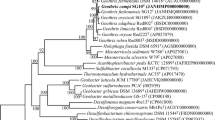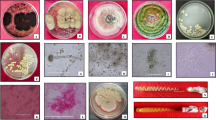Abstract
A novel cellulase-producing actinomycete strain Gxj-6T, isolated from soil in the cold region (Heihe city, Heilongjiang province, the northernmost part of China), subjected to a taxonomic study using a polyphasic approach. In the neighbour-joining phylogenetic tree based on 16S rRNA gene sequences, strain Gxj-6T fell within the clade comprising the type strains of species of the genus Microbispora. 16S rRNA gene sequence similarity studies exhibited that species Gxj-6T was most closely related to Microbispora bryophytorum NEAU-TX2-2T (99.45%), Microbispora fusca NEAU-HEGS1-5T (99.41%), Microbispora camponoti 2C-HV3T (99.31%) and Microbispora rosea subsp. rosea JCM 3006T (98.68%). Organism Gxj-6T contained MK-9(H2) as the predominant ubiquinone and C18:0 10-methyl as the major fatty acid. The major polar lipids of culture Gxj-6T were diphosphatidylglycerol, phosphatidylethanolamine, phosphatidylinositol mannoside, three unidentified phospholipids, two unidentified glycolipids and two unidentified lipids. The DNA G+C content of strain Gxj-6T was 71.25 mol%. The morphological and chemotaxonomic properties of the strain are also consistent with those members of the genus Microbispora. Combinated with the lower DNA–DNA relatedness values, phenotypic properties, physiology and biochemistry distinctiveness with other recognized species strains, revealed that strain Gxj-6T is separated from other phylogenetically closely species of the genus Microbispora. Therefore, strain Gxj-6T is considered to represent a novel species of the genus Microbispora, for which the name Microbispora cellulosiformans sp. nov. is proposed. The type strain is Gxj-6T (= CGMCC 4.7605T = DSM 109712T).


Similar content being viewed by others
References
Atlas RM (1993) Handbook of microbiological media, 4th edn. CRC Press, p 719
Boondaeng A, Ishida Y, Tamura T, Tokuyama S, Kitpreechavanich V (2009) Microbispora siamensis sp. nov., a thermotolerant actinomycete isolated from soil. Int J Syst Evol Microbiol 59:3136–3139
Boondaeng A, Krajangsang S, Trakunjae C, Lomthong T, Tokuyama S, Kitpreechavanich V (2018) Optimization, purification and characterization of beta-xylanase by a novel thermotolerant strain of Microbispora siamensis, DKMUA 245 (T). Chiang Mai J Sci 6:2267–2282
Brosius J, Palmer JL, Kennedy JP, Noller HF (1978) Complete nucleotide sequence of a 16S ribosomal RNA gene from Escherichia coli. Proc Natl Acad Sci USA 75:4801–4805
Collins MD (1985) Isoprenoid quinone analyses in bacterial classification and identification. In: Goodfellow M, Minnikin DE (eds) Chemical methods in bacterial systematics. Academic Press, London, pp 267–284
De Ley J, Cattoir H, Reynaerts A (1970) The quantitative measurement of DNA hybridization from renaturation rates. Eur J Biochem 12:133–142
Duangmal K, Mingma R, Pathom-aree W, Niyomvong N, Inahashi Y, Matsumoto A, Thamchaipenet A, Takahashi Y (2012) Microbispora thailandensis sp. nov., an actinomycete isolated from cave soil. J Antibiot 65:491–494
Felsenstein J (1981) Evolutionary trees from DNA sequences: a maximum likelihood approach. J Mol Evol 17:368–376
Felsenstein J (1985) Confidence limits on phylogenies: an approach using the bootstrap. Evolution 39:783–791
Gordon RE, Barnett DA, Handerhan JE, Pang C (1974) Nocardiacoeliaca, Nocardiaautotrophica, and the nocardin strain. Int J Syst Bacteriol 24:54–63
Han CY, Tian YY, Zhao JW, Yu ZY, Jiang SW, Guo XW, Xiang WS, Wang XJ (2018) Microbispora triticiradicis sp. nov., a novel actinomycete isolated from the root of wheat (Triticum aestivum L.). Int J Syst Evol Microbiol 68:3600–3605
Han CY, Zhao JW, Yu B, Shi HR, Zhang C, Guo XW, Xiang WS, Wang XJ (2019) Microbispora tritici sp. nov., a novel actinomycete isolated from a root of wheat (Triticum aestivum L.). Antonie Van Leeuwenhoek 112:1137–1145
Huss VAR, Festl H, Schleifer KH (1983) Studies on the spectrometric determination of DNA hybridization from renaturation rates. Syst Appl Microbiol 4:184–192
Indananda C, Igarashi Y, Ikeda M, Oikawa T, Thamchaipenet A (2013) Linfuranone A, a new polyketide from plant-derived Microbispora sp. GMKU 363. J Antibiot 66:675–677
Jones KL (1949) Fresh isolates of actinomycetes in which the presence of sporogenous aerial mycelia is a fluctuating characteristic. J Bacteriol 57:141–145
Kämpfer P (2012) Genus I. Streptomyces.. In: Goodfellow M, Kämpfer P, Busse H-J, Trujillo ME, Suzuki K, Ludwig W, Whitman WB (eds) Bergey’s manual of systematic bacteriology, the Actinobacteria, vol 5, 2nd edn. Springer, New York, pp 1455–1462
Kelly KL (1964) Inter-society color council-national bureau of standards color-name charts illustrated with centroid colors published in US
Kimura M (1980) A simple method for estimating evolutionary rates of base substitutions through comparative studies of nucleotide sequences. J Mol Evol 16:111–120
Kittisrisopit S, Pittayakhajonwut P, Tadtong S, Thawai C (2018) Microbispora soli sp. nov., isolated from soil of a hot spring. Int J Syst Evol Microbiol 68:3863–3868
Kittisrisopit S, Bunbamrung N, Thawai C, Tadtong S, Niemhom N, Komwijit S, Rachtawee P, Pittayakhajonwut P (2019) Neuroprotective potential of new chromones isolated from the soil actinomycete Microbispora sp. TBRC6027. Nat Prod Res. DOI https://doi.org/10.1080/14786419.2019.1679135
Klykleung N, Yuki M, Kudo T, Ohkuma M, Phongsopitanun W, Pittayakhajonwut P, Tanasupawat S (2020) Microbispora catharanthi sp. nov., a novel endophytic actinomycete isolated from the root of Catharanthus roseus. Int J Syst Evol Microbiol 70:964–970
Lee YK, Kim HW, Liu CL, Lee HK (2003) A simple method for DNA extraction from marine bacteria that produce extracellular materials. J Microbiol Methods 52:245–250
Li R, Li Y, Kristiansen K, Wang J (2008) Soap: short oligonucleotide alignment program. Bioinformatics 24:713–714
Li RQ, Zhu HM, Ruan J, Qian WB, Fang XD, Shi ZB, Li YR, Li ST, Shan G, Kristiansen K (2010) De novo assembly of human genomes with massively parallel short read sequencing. Genome Res 20:265–272
Li C, Zhang YJ, Liu CX, Wang HY, Zhao JW, Li LJ, Zhang ZW, Wang XJ, Xiang WS (2015) Microbispora bryophytorum sp. nov., an actinomycete isolated from moss (Bryophyta). Int J Syst Evol Microbiol 65:1274–1279
Loqman S, Barka EA, Clément C, Ouhdouch Y (2009) Antagonistic actinomycetes from Moroccan soil to control the grapevine gray mold. World J Microbiol Biotechnol 25:81–91
Mandel M, Marmur J (1968) Use of ultraviolet absorbance temperature profile for determining the guanine plus cytosine content of DNA. Methods Enzymol 12B:195–206
McKerrow J, Vagg S, McKinney T, Seviour EM, Maszenan AM, Brooks P, Seviou RJ (2000) A simple HPLC method for analyzing diaminopimelic acid diastereomers in cell walls of Gram-positive bacteria. Lett Appl Microbiol 30:178–182
Minnikin DE, Hutchinson IG, Caldicott AB, Goodfellow M (1980) Thin-layer chromatography of methanolysates of mycolic acid-containing bacteria. J Chromatogr 188:221–233
Minnikin DE, O’Donnell AG, Goodfellow M, Alderson G, Athalye M, Schaal A, Parlett JH (1984) An integrated procedure for the extraction of bacterial isoprenoid quinines and polar lipids. J Microbiol Methods 2:233–241
Miyadoh S, Amano S, Tohyama H, Shomura T (1990) A taxonomic review of the genus Microbispora and a proposal to transfer two species to the genus Actinomadura and to combine ten species into Microbispora rosea. J Gen Microbiol 136:1905–1913
Nakajima Y, Kitpreechavanich V, Suzuki K, Kudo T (1999) Microbispora corallina sp. nov., a new species of the genus Microbispora isolated from Thai soil. Int J Syst Bacteriol 49:1761–1767
Nolan RD, Cross T (1988) Isolation and screening of actinomycetes. In: Goodfellow M, Williams ST, Mardarski M (eds) Actinomycetes in biotechnology. Academic Press, London, pp 2–8
Nonomura H, Ohara Y (1957) Distribution of actinomycetes in soil. II. Microbispora, a new genus of the Streptomycetaceae. J Ferment Technol 35:307–311
Nonomura H, Ohara Y (1960) Distribution of the actinomycetes in soil. IV. The isolation and classification of the genus Microbispora. J Ferment Technol 38:401–405
Saitou N, Nei M (1987) The neighbor-joining method: a new method for reconstructing phylogenetic trees. Mol Biol Evol 4:406–425
Sasser M (1990) Identification of bacteria by gas chromatography of cellular fatty acids. MIDI Technical Note 101 MIDI Inc
Shirling EB, Gottlieb D (1966) Methods for characterisation of Streptomyces species. Int J Syst Bacteriol 16:313–340
Smibert RM, Krieg NR (1994) Phenotypiccharacterisation. In: Gerhardt P, Murray RGE, Wood WA, Krieg NR (eds) Methods for generaland molecular bacteriology. American Society for Microbiology, Washington, DC, pp 607–654
Tamura K, Stecher G, Peterson D, Filipski A, Kumar S (2013) MEGA6: molecular evolutionary genetics analysis version 6.06. Mol Biol Evol 30:2725–2729
Waksman SA (1961) The Actinomycetes, vol 2, Classification, identification and descriptions of genera and species. Williams and Wilkins, Baltimore
Wayne LG, Brenner DJ, Colwell RR, Grimont PAD, Kandler O, Krichevsky MI, Moore LH, Moore WEC, Murray RGE (1987) International Committee on Systematic Bacteriology. Report of the ad hoc committee on reconciliation of approaches to bacterial systematics. Int J Syst Bacteriol 37:463–464
Wu C, Lu X, Qin M, Wang Y, Ruan J (1989) Analysis of menaquinone compound in microbial cells by HPLC. Microbiology [English translation of Microbiology (Beijing)] 16:176–178
Xu XX, Wang HL, Lin HP, Wang C, Qu Z, Xie QY, Ruan JS, Hong K (2012) Microbispora hainanensis sp. nov., isolated from rhizosphere soil of Excoecaria agallocha in a mangrove. Int J Syst Evol Microbiol 62:2430–2434
Yokota A, Tamura T, Hasegawa T, Huang LH (1993) Catenuloplanes japonicas gen. nov., sp. nov., nom. rev., a new genus of the order Actinomycetales. Int J Syst Bacteriol 43:805–812
Yoon SH, Ha SM, Kwon S, Lim J, Kim Y, Seo H, Chun J (2017) Introducing EzBioCloud: a taxonomically united database of 16S rRNA gene sequences and whole-genome assemblies. Int J Syst Evol Microbiol 67:1613
Zhang ZS, Wang Y, Ruan JS (1998) Reclassification of Thermomonospora and Microbispora. Int J Syst Bacteriol 48:411–422
Zhao XQ, Li WJ, Jiao WC, Li Y, Yuan WJ (2009) Streptomyces xinghaiensis sp. nov., isolated from marine sediment. Int J Syst Evol Microbiol 59:2870–2874
Zhao JW, Yu B, Han CY, Cao P, Yu ZY, Ju HX, Xiang WS, Wang XJ (2019) Microbispora fusca sp. nov., a novel actinomycete isolated from the ear of wheat (Triticum aestivum L.). Int J Syst Evol Microbiol. https://doi.org/10.1099/ijsem.0.003725
Zhi XY, Li WJ, Stackebrandt E (2009) An update of the structure and 16S rRNA gene sequence-based definition of higher ranks of the class Actinobacteria, with the proposal of two new suborders and four new families and emended descriptions of the existing higher taxa. Int J Syst Evol Microbiol 59:589–608
Acknowledgements
We would like to thank Professor Wensheng Xiang at the Northeast Agricultural University, People’s Republic of China, for providing us with the similarity strain Microbispora fusca NEAU-HEGS1-5T and Microbispora camponoti 2C-HV3T. This work was supported in part by grants from Harbin applied technology research and development project (NO. 2017RAQYJ142) and Science and technology cooperation project of Heilongjiang Provincial Science and Technology Planning Institute (NO. YS18B14). We are also grateful to Professor Aharon Oren for helpful advice on the specific epithet.
Author information
Authors and Affiliations
Contributions
XG, HZ, CQ conceived the idea of the study; WX provided the similar strains; XG, XC, YY analysed the data; XG, HZ, YH, LL, QW interpreted the results; XG wrote the paper; all authors discussed the results and revised the manuscript.
Corresponding authors
Ethics declarations
Conflict of interest
The authors declare that they have no conflict of interest. Informed consent was obtained from all individual participants included in the study.
Ethical statement
I certify that this manuscript is original and has not been published and will not be submitted elsewhere for publication while being considered by Hongtao Zou. And the study is not split up into several parts to increase the quantity of submissions and submitted to various journals or to one journal over time. No data have been fabricated or manipulated (including images) to support our conclusions. The submission has been received explicitly from all co-authors. And authors whose names appear on the submission have contributed sufficiently to the scientific work and therefore share collective responsibility and accountability for the results.
Additional information
Publisher's Note
Springer Nature remains neutral with regard to jurisdictional claims in published maps and institutional affiliations.
Electronic supplementary material
Below is the link to the electronic supplementary material.
Rights and permissions
About this article
Cite this article
Gong, X., Xiang, W., Cao, X. et al. Microbispora cellulosiformans sp. nov., a novel actinomycete with cellulase activity isolated from soil in the cold region. Antonie van Leeuwenhoek 113, 2053–2062 (2020). https://doi.org/10.1007/s10482-020-01477-4
Received:
Accepted:
Published:
Issue Date:
DOI: https://doi.org/10.1007/s10482-020-01477-4




